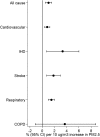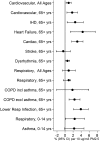Epidemiological time series studies of PM2.5 and daily mortality and hospital admissions: a systematic review and meta-analysis
- PMID: 24706041
- PMCID: PMC4078677
- DOI: 10.1136/thoraxjnl-2013-204492
Epidemiological time series studies of PM2.5 and daily mortality and hospital admissions: a systematic review and meta-analysis
Abstract
Background: Short-term exposure to outdoor fine particulate matter (particles with a median aerodynamic diameter <2.5 μm (PM2.5)) air pollution has been associated with adverse health effects. Existing literature reviews have been limited in size and scope.
Methods: We conducted a comprehensive, systematic review and meta-analysis of 110 peer-reviewed time series studies indexed in medical databases to May 2011 to assess the evidence for associations between PM2.5 and daily mortality and hospital admissions for a range of diseases and ages. We stratified our analyses by geographical region to determine the consistency of the evidence worldwide and investigated small study bias.
Results: Based upon 23 estimates for all-cause mortality, a 10 µg/m(3) increment in PM2.5 was associated with a 1.04% (95% CI 0.52% to 1.56%) increase in the risk of death. Worldwide, there was substantial regional variation (0.25% to 2.08%). Associations for respiratory causes of death were larger than for cardiovascular causes, 1.51% (1.01% to 2.01%) vs 0.84% (0.41% to 1.28%). Positive associations with mortality for most other causes of death and for cardiovascular and respiratory hospital admissions were also observed. We found evidence for small study bias in single-city mortality studies and in multicity studies of cardiovascular disease.
Conclusions: The consistency of the evidence for adverse health effects of short-term exposure to PM2.5 across a range of important health outcomes and diseases supports policy measures to control PM2.5 concentrations. However, reasons for heterogeneity in effect estimates in different regions of the world require further investigation. Small study bias should also be considered in assessing and quantifying health risks from PM2.5.
Keywords: Asthma Epidemiology; COPD epidemiology.
Published by the BMJ Publishing Group Limited. For permission to use (where not already granted under a licence) please go to http://group.bmj.com/group/rights-licensing/permissions.
Figures



References
-
- WHO. Air Quality Guidelines. Global Update 2005. Copenhagen: World Health Organisation Regional Office for Europe, 2006
-
- WHO. Health relevance of particulate matter from various sources. Report on a WHO workshop Bonn, Germany 26–27 March 2007. http://www.euro.who.int/data/assets/pdf_file/0007/78658/E90672.pdf [accessed June 2010].
-
- Health Effects Institute. Health Effects of Outdoor Air Pollution in Developing Countries of Asia: A Literature Review. Special Report 15, 2004
-
- Pope CA, 3rd, Dockery DW. Health effects of fine particulate air pollution: lines that connect. J Air Waste Manage Assoc 2006;56:709–42 - PubMed
-
- U.S. EPA. Integrated Science Assessment for Particulate Matter (Final Report). U.S. Environmental Protection Agency, Washington, DC, EPA/600/R-08/139F, 2009. http://cfpub.epa.gov/ncea/cfm/recordisplay.cfm?deid=216546#Download [accessed 15 June 2013]. - PubMed
Publication types
MeSH terms
Substances
Grants and funding
LinkOut - more resources
Full Text Sources
Other Literature Sources
